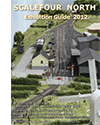
 The track plan of Witton Junction Engine Shed is loosely based on an engine shed that existed at the junction of the
Wearhead Branch and the Bishop Auckland to Crook line in Durham. It was constructed to house
locomotives allocated to Shildon which were outbased for working in the Wear Valley area, and
originally named Witton Junction on the Architects Drawings, renamed Wear Valley probably during
construction. The shed layout was different from other NER sheds, being a part roundhouse, hence
the initial interest in creating a model. No other similar NER structure is known
although other pre-group companies had similar sheds, e.g. Berwick NBR. Photographs show six stalls but copies of original drawings show a proposed extension to eleven stalls.
To try to determine the final arrangement, I have carried out some "on site" excavation and
believe the building plan was as modelled here. The roof arrangement is more difficult to determine,
a recently located photograph shows a different arrangement from the drawing, but I prefer
the multi-ridge style, and have modelled that. The Colliery trackwork, bridge and adjacent approach
tracks are unprototypical, forming part of an extension to the model.
The track plan of Witton Junction Engine Shed is loosely based on an engine shed that existed at the junction of the
Wearhead Branch and the Bishop Auckland to Crook line in Durham. It was constructed to house
locomotives allocated to Shildon which were outbased for working in the Wear Valley area, and
originally named Witton Junction on the Architects Drawings, renamed Wear Valley probably during
construction. The shed layout was different from other NER sheds, being a part roundhouse, hence
the initial interest in creating a model. No other similar NER structure is known
although other pre-group companies had similar sheds, e.g. Berwick NBR. Photographs show six stalls but copies of original drawings show a proposed extension to eleven stalls.
To try to determine the final arrangement, I have carried out some "on site" excavation and
believe the building plan was as modelled here. The roof arrangement is more difficult to determine,
a recently located photograph shows a different arrangement from the drawing, but I prefer
the multi-ridge style, and have modelled that. The Colliery trackwork, bridge and adjacent approach
tracks are unprototypical, forming part of an extension to the model.
Trackwork is hand-built using mainly plywood sleepers and nickel silver rail. Obtaining a satisfactory and reliable operating turntable has proved difficult, the present
arrangement being the fourth attempt and working electrics now being much simplified. The buildings are scratchbuilt from a
combination of plastic, card and featherboard, with the shed roof of brass and nickel silver sections, plywood and plastic card.
The locomotive stock by Ian Sadler and myself is generally numerically correct for the Wear Valley area in the period modelled –
1910, and includes NER classes A, B, C, E, G, 0, P, P1, P2, Q, T, U, BTP, 298, 398 and 964A. It should be noted however that the
number of locomotives on the layout would not be prototypical at this location, when a maximum of up to six would be normal.
Other rolling stock is either kit or scratch built.
Presented by Dave Fenney
































